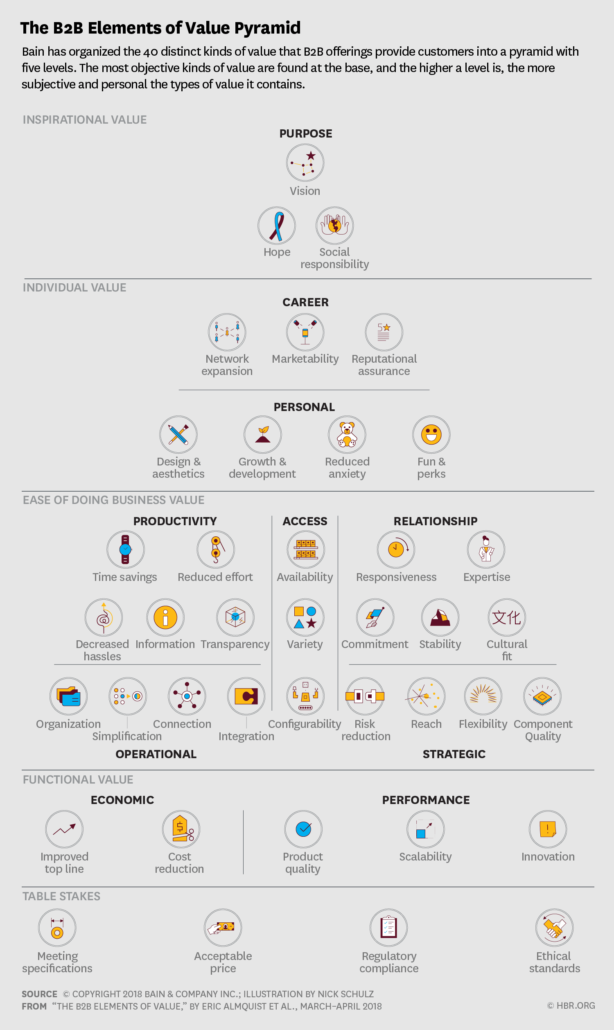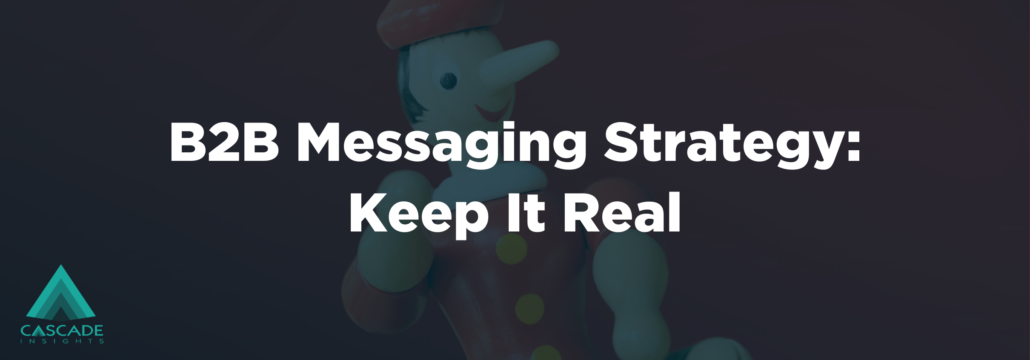It’s tempting to develop a messaging strategy that overemphasizes the inspirational, uplifting, and idealistic aspects of your brand. Unfortunately, many marketers take it too far, forgetting that inauthentic messaging turns many buyers off. B2B tech sector buyers are particularly skeptical of boasts with no evidence to back them up.
Do your marketing boasts sound overblown? Here are some tips for gauging whether your messaging sounds authentic.
Messaging Needs to Inspire Trust Rather Than Suspicion
“Any B2B messaging that has a superlative in it is viewed with skepticism.” – Tyler Honsinger, Senior Consultant, Cascade Insights®
B2B buyers are inherently cautious, and have a dim view of any marketing boasts they see that don’t come with proof. Think “fastest” with no statistics and competitor comparisons, or “industry leading” with no accompanying reference to a prestigious ranking.
As B2B buyers increasingly look to companies for help with making critical purchasing decisions, any inauthentic messaging you put out only impedes them. B2B buyers face a complex buying journey, and your messaging should help them sort through information overload, give them confidence in making decisions, and reassure them that the right decision was made. Empty bragging provides no useful information, or worse, misleads and/or turns off your buyers. Don’t do it.
Messaging Isn’t Just About Communicating Function, Consider What Feeling You Want Your Brand & Solutions to Convey
Authenticity in your messaging strategy can provide real value for your company. According to the B2B Elements of Value pyramid, B2B buyers have a spectrum of priorities, ranging from table stakes to inspirational. As competing on price and features becomes more straightforward, differentiation begins to occur in more subjective values higher in the pyramid such as reputational assurance and social responsibility. If your brand or solution is tied with a competitor on table stakes, your peak elements of value might get you over the line with your buyers.

Additionally, peak elements of value have a larger impact on customer satisfaction and net promoter score (NPS) than base elements.
When marketers try to imagine the most important motivators for buyers, honesty, transparency, and embracing action often feel like fluffy bonus points. However, research shows these values not only create value, but also retain it down the road as well, in the form of customer loyalty.
Here’s how you can build trust with your buyers by staying authentic in your messaging strategy.
Don’t Lie
Sounds easy, right? Unfortunately, many companies still seem to get this wrong. Making a false claim may make you look more trendy, innovative, or ethical than you really are – but only if the buyer believes you.
For example, consider greenwashing. Greenwashing is the practice of making overblown claims of environmental friendliness to gain market share. In both the B2B and B2C spaces, demand for greener products and services has led to increased messaging touting environmentally-friendly attributes – often without merit.
Worse still, some companies get involved in watering down green standards, creating loopholes so their products make the grade more easily. Take Apple’s popular MacBook laptop, a common feature in many offices. Traditionally modular and repairable, in 2012, a MacBook Pro was launched that could not be repaired or upgraded. Nevertheless, it featured a “Gold” EPEAT (Electronic Product Environmental Assessment Tool) rating, despite the standard stipulating that a device should be easily repairable. The language governing the EPEAT standard had become so obfuscated by corporate stakeholders that it had essentially become unenforceable and therefore meaningless. Even today, a cursory Google search reveals that electronics manufacturers struggle with meaningful environmental efforts, despite ubiquitous corporate “sustainability” webpages.
All this lying has led to a dire consequence: greenwashing is so pervasive that customers can now simultaneously identify a green claim and be turned off by it. If that’s not a damning assessment of a failure of messaging, I don’t know what is.
Resist the temptation to make a trendy claim if it’s not true. It will hurt you in the long run, or at least give your team a mountain to climb to regain lost credibility.
Buyers Won’t Just Take Your Word For It
According to a 2020 TrustRadius study, B2B marketers have been growing increasingly out of touch with what buyers want to see during procurement. While 77 percent of buyers say it is very important to understand the cons of a product or service before purchase, only 33 percent of vendors think so. That gap is growing every year.
In the absence of “real talk” from vendors, B2B buyers are increasingly turning to review sites to understand others’ experiences. In fact, 39 percent of B2B buyers say this assessment is critical in the buying process.
Think about what this means: despite all your messaging efforts, buyers are still trying to gain clarity by googling to figure out if your boasts are true. The rise of third party review sites is an indicator of how little buyers actually trust companies’ own messaging.
Don’t Pretend Like You Have The Solution to Every Problem
B2B messaging should always clarify what the product or service does not do. Being upfront about your solution’s limitations saves buyers’ time and reduces confusion. Forcing buyers to dig through your website looking for what you don’t do leaves them frustrated. They’ll likely end up with a bad impression of you, and this sour first impression may deter them when they search for a solution you do provide.
Worse still, glossing over limitations leads to frustrated customers later on when they realize they didn’t get what they paid for. That leads to churn and bad reviews, which turns other prospective buyers away.
Conversely, clearly laying out your solution’s limitations gives buyers an accurate picture of how best they can utilize it. Remember, the majority of buyers want to understand the cons of a product or service before purchase. Filling in the information gaps for them can only be mutually beneficial.
Don’t try to hide your limitations. Acknowledge them so you’re not wasting time for buyers you’re not a good fit for.
Being Real is a Winning Strategy
In sum, dishonest messaging and overblown boasts make you work much harder to rebuild credibility.
Succeed in building a posture of authenticity, and you’ll win over B2B buyers looking to build lasting, trusting relationships. Stay authentic, and be top of mind – and heart – with your buyers.
This article is brought to you by Cascade Insights®. Need help conveying authentic value to B2B buyers? We can help. Cascade Insights®’ B2B messaging services helps companies build trust in their brand and win over more of their target market.
For advising on this article, special thanks to Director of Messaging Isa Gautschi.

